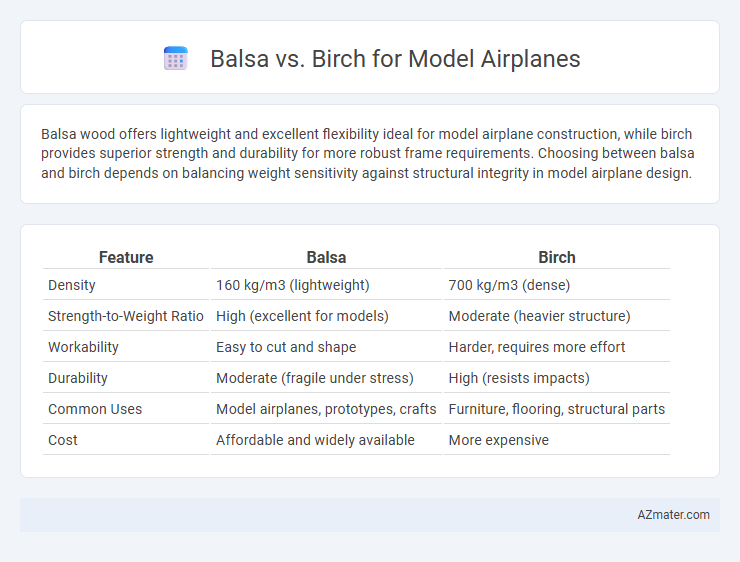Balsa wood offers lightweight and excellent flexibility ideal for model airplane construction, while birch provides superior strength and durability for more robust frame requirements. Choosing between balsa and birch depends on balancing weight sensitivity against structural integrity in model airplane design.
Table of Comparison
| Feature | Balsa | Birch |
|---|---|---|
| Density | 160 kg/m3 (lightweight) | 700 kg/m3 (dense) |
| Strength-to-Weight Ratio | High (excellent for models) | Moderate (heavier structure) |
| Workability | Easy to cut and shape | Harder, requires more effort |
| Durability | Moderate (fragile under stress) | High (resists impacts) |
| Common Uses | Model airplanes, prototypes, crafts | Furniture, flooring, structural parts |
| Cost | Affordable and widely available | More expensive |
Introduction to Balsa and Birch in Model Airplanes
Balsa wood, known for its exceptional lightness and easy workability, is the preferred material for model airplanes requiring high strength-to-weight ratios and intricate detail shaping. Birch, while heavier and denser than balsa, offers superior durability and impact resistance, making it suitable for model airplane components subjected to higher stress and wear. Both woods are commonly used in model airplane construction, with balsa favored for aerodynamic surfaces and birch chosen for structural parts where added toughness is essential.
Material Properties: Balsa vs Birch
Balsa wood is significantly lighter and softer than birch, offering superior buoyancy and ease of shaping, which makes it ideal for lightweight model airplanes requiring agility and quick construction. In contrast, birch is denser and harder, providing enhanced structural strength and durability, suitable for models demanding greater rigidity and resistance to impacts. The choice between balsa and birch hinges on balancing weight sensitivity versus strength requirements in model airplane design.
Weight Comparison: Balsa vs Birch
Balsa wood is significantly lighter than birch, with a typical density of 160-320 kg/m3 compared to birch's 670-710 kg/m3, making balsa the preferred choice for model airplanes where minimizing weight is crucial. Birch's higher density results in increased strength and durability but adds substantial weight, which can negatively impact flight performance in lightweight models. For optimal weight-to-strength balance, model airplane builders often use balsa for the frame while employing birch for areas requiring enhanced structural support.
Strength and Durability Differences
Balsa wood offers superior strength-to-weight ratio, making it highly favored for lightweight model airplane construction, yet it tends to be less durable and more prone to dents and moisture damage. Birch wood, while heavier, provides greater overall durability and resistance to wear, suitable for parts of the model requiring enhanced structural integrity. Model builders often choose balsa for the frame to maximize flight performance and birch for load-bearing components to increase longevity.
Workability and Ease of Shaping
Balsa wood is renowned for its exceptional workability and ease of shaping due to its lightweight and soft texture, making it ideal for intricate model airplane designs. Birch, being denser and harder, offers greater durability but requires more effort and sharper tools for cutting and sanding. Modelers often prefer balsa for quick, precise modifications, while birch suits components needing added strength without frequent reshaping.
Cost and Availability for Hobbyists
Balsa wood remains the most popular choice for model airplane hobbyists due to its low cost and widespread availability in hobby shops and online stores, making it ideal for budget-conscious builders. Birch, while offering greater strength and durability, tends to be more expensive and less readily available in lightweight sheets specifically suited for model airplanes. Hobbyists often prioritize balsa wood for ease of construction and affordability, reserving birch for specialized parts where additional strength is required.
Performance Impact on Flight Characteristics
Balsa wood, being lightweight and flexible, significantly enhances a model airplane's lift-to-weight ratio, resulting in improved gliding performance and longer flight duration. Birch, denser and stiffer, provides increased structural strength and better resistance to aerodynamic stresses, which enhances durability but can reduce overall flight agility and maneuverability. Choosing between balsa and birch directly impacts the balance between flight efficiency and airframe robustness, with balsa favoring smoother, extended flights and birch supporting more aggressive handling and resilience.
Suitability for RC vs Free-Flight Models
Balsa wood offers a lightweight structure ideal for free-flight models, enhancing gliding performance and extended air time due to its excellent strength-to-weight ratio. Birch, being denser and stronger, provides superior durability and rigidity, making it better suited for RC models that undergo frequent handling and require more robust control surfaces. The choice between balsa and birch ultimately depends on whether weight savings or structural strength is prioritized in the specific model airplane design.
Environmental Considerations and Sourcing
Balsa wood, known for its lightweight and renewable growth within 5-10 years, offers a more sustainable option for model airplane construction compared to birch, which grows slower and demands more intensive harvesting practices. Birch, often sourced from older forests and requiring more energy in processing due to its density, has a higher environmental impact through increased carbon emissions and habitat disruption. Choosing sustainably harvested balsa from certified plantations reduces deforestation risks and supports eco-friendly modeling, whereas sourcing birch often involves stricter regulatory oversight and greater ecological footprint.
Choosing Between Balsa and Birch: Key Factors
Choosing between balsa and birch for model airplanes depends on weight, strength, and workability. Balsa wood is exceptionally lightweight and easy to shape, making it ideal for gliders and lightweight models, while birch offers superior strength and durability suitable for more robust structures. Considering project requirements, balsa suits designs prioritizing flight efficiency, whereas birch excels in durability and structural integrity.

Infographic: Balsa vs Birch for Model Airplane
 azmater.com
azmater.com